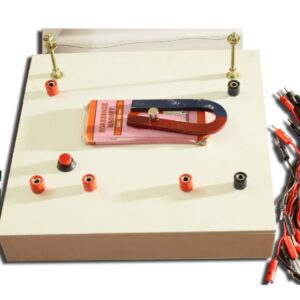a. NATURE OF MATERIAL AND RESISTANCE b. LENGTH OF CONDUCTOR AND RESISTANCE c. CROSS SECTION AREA AND RESISTANCE WORKING MODEL
SCIENCE LAB EQUIPMENT WORKING MODEL / SCIENCE EXHIBITION WORKING MODEL
3 in stock
a. NATURE OF MATERIAL AND RESISTANCE b. LENGTH OF CONDUCTOR AND RESISTANCE c. CROSS SECTION AREA AND RESISTANCE
Certainly! Let’s explore both concepts:
**a. Nature of Material and Resistance:**
1. **Explanation:** The nature of the material through which electric current flows significantly affects its resistance. Different materials exhibit varying levels of resistance due to their atomic and molecular structures.
2. **Conductors and Insulators:**
– **Conductors:** Materials like metals have low resistance because they offer little opposition to the flow of electrons. This is because they have free electrons that can move easily through the material.
– **Insulators:** Materials like rubber or plastic have high resistance because they do not allow electrons to flow freely. They tightly hold onto their electrons, making it difficult for electric current to pass through.
3. **Semiconductors:** Some materials, like silicon or germanium, have properties between those of conductors and insulators. They have a moderate level of resistance that can be controlled by adding impurities or applying voltage, making them useful in electronic devices.
**b. Length of Conductor and Resistance:**
1. **Explanation:** The length of a conductor also affects its resistance. In general, as the length of a conductor increases, its resistance also increases, and vice versa. This relationship is described by the formula for resistance:
\[ R = rho x L / A ]
Where:
– \( R \) is the resistance of the conductor.
– \( \rho \) is the resistivity of the material (a constant).
– \( L \) is the length of the conductor.
– \( A \) is the cross-sectional area of the conductor.
2. **Effect on Resistance:**
– When the length of the conductor increases, the number of collisions between electrons and atoms or molecules also increases. This increased collision results in higher resistance.
– Conversely, when the length decreases, there are fewer collisions, leading to lower resistance.
3. **Practical Implications:**
– In electrical circuits, longer wires or conductors generally have higher resistance, which can lead to voltage drops and power losses.
– To minimize resistance in circuits, engineers often use thicker wires or reduce the length of the conductors where possible.
**Teaching Suggestions:**
– Conduct simple experiments demonstrating the effects of different materials or wire lengths on resistance.
– Use real-life examples such as electrical wiring in buildings or electronic components to illustrate the concepts of resistance due to material nature and conductor length.
– Encourage students to calculate resistance using the formula and analyze how it changes with variations in material and length.
a. Nature of Material and Resistance:
- Different materials have different resistivities, which determine their resistance to the flow of electrical current.
- Materials with high resistivity have higher resistance, while materials with low resistivity have lower resistance.
- For example, materials like copper and aluminum have low resistivity and are commonly used in electrical conductors due to their efficient conduction of electricity.
b. Length of Conductor and Resistance:
- The resistance of a conductor is directly proportional to its length.
- Longer conductors offer more opposition to the flow of current compared to shorter conductors.
- This relationship is described by the formula: �=���, where � is resistance, � is resistivity, � is length, and � is the cross-sectional area of the conductor.
c. Cross-Sectional Area and Resistance:
- The resistance of a conductor is inversely proportional to its cross-sectional area.
- Conductors with larger cross-sectional areas offer less opposition to the flow of current compared to conductors with smaller cross-sectional areas.
- This relationship is described by the formula: �=���, where � is resistance, � is resistivity, � is length, and � is the cross-sectional area of the conductor.
Understanding these factors helps in designing and selecting appropriate conductors for various electrical applications. Conductors with lower resistance are preferred for efficient transmission of electricity and minimizing energy losses.
| Weight | 0.5 kg |
|---|---|
| Dimensions | 25 × 25 × 5 cm |
You must be logged in to post a review.








Reviews
There are no reviews yet